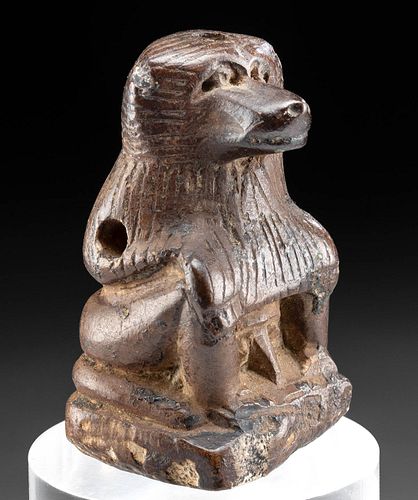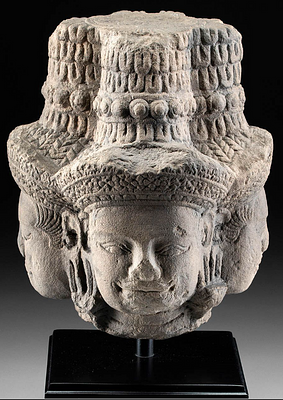Exhibited Egyptian Stone Effigy Ibis-Headed Thoth
About Seller
686 S Taylor Ave, Ste 106
Louisville, CO 80027
United States
Selling antiquities, ancient and ethnographic art online since 1993, Artemis Gallery specializes in Classical Antiquities (Egyptian, Greek, Roman, Near Eastern), Asian, Pre-Columbian, African / Tribal / Oceanographic art. Our extensive inventory includes pottery, stone, metal, wood, glass and textil...Read more
Two ways to bid:
- Leave a max absentee bid and the platform will bid on your behalf up to your maximum bid during the live auction.
- Bid live during the auction and your bids will be submitted real-time to the auctioneer.
Bid Increments
| Price | Bid Increment |
|---|---|
| $0 | $25 |
| $300 | $50 |
| $1,000 | $100 |
| $2,000 | $250 |
| $5,000 | $500 |
| $10,000 | $1,000 |
| $20,000 | $2,500 |
| $50,000 | $5,000 |
| $100,000 | $10,000 |
| $200,000 | $20,000 |
About Auction
Jun 29, 2023
Artemis Fine Arts info@artemisfinearts.com
- Lot Description
Ancient Egypt, Late Dynastic Period, 26th to 31st Dynasty, ca. 664 to 332 BCE. A hand-carved stone figure of ibis-headed Thoth, the god of writing, accounting, and mathematics, in his more unusual simian form. The regal baboon sits atop an integral pentagonal with both knees drawn up to the chest and hands on top, his exposed phallus between, with a sweeping cape of hair in front bearing dozens of incised striations. His serene face presents with almond-shaped eyes beneath sweeping brows, a protruding snout with a sharp nasal ridge, gaunt cheeks, and a puffy coiffure. Drilled suspension holes through the top and bottom as well as laterally just above each elbow indicate that this effigy was worn as a pendant, either by the living or the dead. Size: 1.35" L x 1.47" W x 2.37" H (3.4 cm x 3.7 cm x 6 cm)
According to Egyptologists Erik Hornung and Betsy M. Bryan, "As primeval animals, baboons and green monkeys were prominent parts of the Egyptian cosmogony. The earliest gods are sometimes depicted with baboon heads. The baboon became an aspect of the sun god, Re . . . And of the moon god, Thoth-Khonsu. Thoth (Djehuty in ancient Egyptian) was the god of writing and knowledge, who was depicted in the form of two animals: the baboon (Papio cynocephalus) and the sacred Ibis (Threskiornis aethiopicus). In his baboon form Thoth was closely associated with the baboon god, Hedj-wer (the great white one) of the Early Dynastic period. By the end of the Old Kingdom (2686 - 2181 BCE) he was usually portrayed as an ibis-headed man, holding a scribal palette and pen or a notched palm leaf, performing some kind of act of recording or calculation." (Hornung, Erik and Betsy M. Bryan, eds. "The Quest for Immortality: Treasures of Ancient Egypt." National Gallery of Art, Washington, 2002, p. 200)
Exhibited in the Robert and Frances Fullerton Museum of Art (RAFFMA), California State University, San Bernardino from 2005 to 2023, reference number EL01.001.2005.
Cf. similar examples at The Metropolitan Museum of Art, accession numbers 89.2.223 and 17.194.2438.
Provenance: Collection of Dr. W. Benson Harer, Los Angeles, California, USA; Exhibited in the Robert and Frances Fullerton Museum of Art (RAFFMA), California State University, San Bernardino from 2005 to 2023, reference number EL01.001.2005
All items legal to buy/sell under U.S. Statute covering cultural patrimony Code 2600, CHAPTER 14, and are guaranteed to be as described or your money back.
A Certificate of Authenticity will accompany all winning bids.
We ship worldwide and handle all shipping in-house for your convenience.
#178995Condition
Small chips to head and base plinth, and darkening to surface color commensurate with age, otherwise intact and excellent. Great preservation to simian form and wonderful preservation to finer details.
- Shipping Info
-
All shipping is handled in-house for your convenience. Your invoice from Artemis Gallery will include shipping calculation instructions. If in doubt, please inquire BEFORE bidding for estimated shipping costs for individual items.
-
- Buyer's Premium



 EUR
EUR CAD
CAD AUD
AUD GBP
GBP MXN
MXN HKD
HKD CNY
CNY MYR
MYR SEK
SEK SGD
SGD CHF
CHF THB
THB











